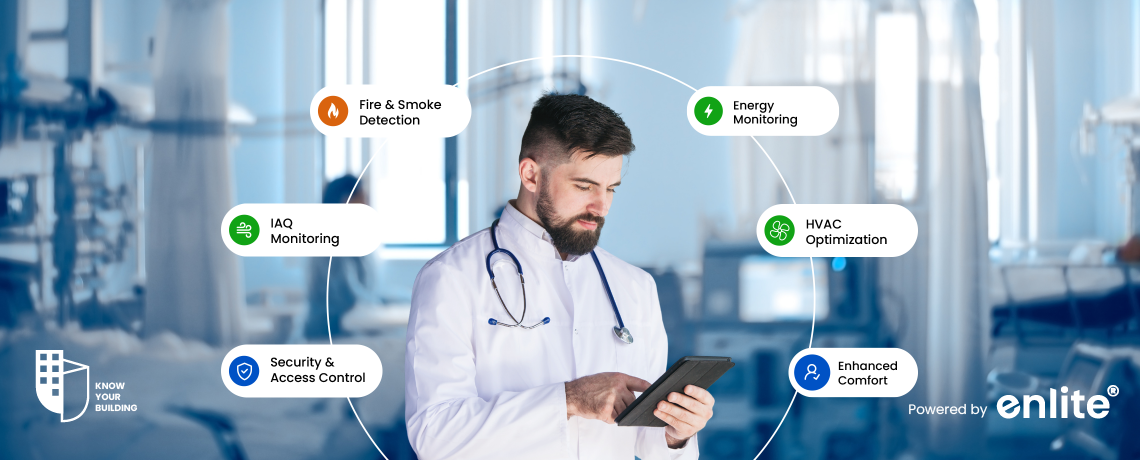Data Insights:
- The global smart healthcare market is projected to reach $237.6 billion by 2025, growing at a 27.7% CAGR.
- Healthcare facilities can achieve 20-30% energy savings by implementing Building Management Systems (BMS).
- BMS implementation in hospitals has been shown to reduce maintenance costs by 10-20% through predictive maintenance.
Introduction: The Importance of BMS in Healthcare Facilities
Healthcare facilities, from hospitals to clinics, are some of the most critical infrastructure in any community. Efficiently managing these facilities is essential, not only for ensuring patient care but also for ensuring operational efficiency, sustainability, and cost-effectiveness.
A Building Management System (BMS) plays a key role in enhancing the management of healthcare facilities by integrating and optimizing various building systems like heating, ventilation, air conditioning (HVAC), lighting, security, and more. By automating and streamlining operations, BMS improves energy efficiency, ensures patient comfort, and helps healthcare providers create a safer, more sustainable environment for patients, staff, and visitors.
Key Benefits of BMS in Healthcare Facilities:
- Energy Efficiency and Cost Savings:
- HVAC Optimization: BMS systems monitor and adjust HVAC systems to optimize temperature control, reducing energy waste while maintaining a comfortable environment for patients and staff.
- Lighting Control: BMS automatically adjusts lighting based on occupancy or natural daylight, saving energy and reducing operational costs.
- Energy Consumption Analytics: By analyzing energy consumption patterns, a BMS can identify inefficiencies and suggest adjustments to reduce energy bills.
- Improved Indoor Air Quality (IAQ):
- Ventilation Management: BMS systems can monitor and control air circulation, ensuring adequate ventilation in healthcare facilities. Proper ventilation is essential for reducing the risk of airborne infections and ensuring a safe environment.
- Air Quality Monitoring: The system can detect levels of CO2, particulates, and other contaminants, alerting facilities managers to potential air quality issues.
- Patient Comfort: Proper air circulation and temperature control directly affect the comfort of patients, contributing to their recovery and well-being.
- Enhanced Patient and Staff Comfort:
- Temperature Control: BMS ensures that different areas of the healthcare facility maintain the appropriate temperature. This is crucial in areas like operating rooms, patient wards, and recovery rooms where precise climate control is required.
- Noise Reduction: A well-maintained BMS can help control ambient noise levels by managing HVAC systems, ensuring a quiet, peaceful environment conducive to healing.
- Lighting Control: Adjusting lighting to meet different needs at various times of day or night promotes better patient outcomes and comfort.
- Predictive Maintenance for Minimizing Downtime:
- Early Fault Detection: BMS integrates sensors that continuously monitor the performance of critical equipment (HVAC systems, fire alarms, etc.). Predictive maintenance alerts help staff take action before a failure occurs, reducing costly downtime.
- Reduced Maintenance Costs: By proactively addressing potential issues, BMS reduces the need for expensive repairs and prolongs the lifespan of equipment, leading to cost savings.
- Regulatory Compliance and Safety:
- Temperature and Humidity Regulation: BMS helps healthcare facilities comply with strict standards for temperature and humidity control in sensitive areas like pharmaceuticals storage or sterile environments.
- Emergency Alerts and Reporting: The system provides real-time alerts in case of system failures, such as HVAC or power outages, ensuring swift responses to maintain patient safety.
- Monitoring Infection Control: BMS can help manage air circulation and temperature to reduce the risk of infections, which is especially important in critical care units.
- Sustainability and Green Building Certifications:
- Energy Consumption Monitoring: A BMS helps track and reduce energy use, contributing to sustainability goals and supporting green building certifications (e.g., LEED).
- Water Usage Optimization: In addition to energy management, BMS can help monitor water usage in healthcare facilities, reducing waste and supporting conservation efforts.
- Reduced Carbon Footprint: By optimizing energy consumption and minimizing waste, BMS reduces the overall carbon footprint of the healthcare facility.
- Improved Workflow for Healthcare Professionals:
- Centralized Control: A BMS provides a centralized dashboard that allows healthcare facility managers to monitor and control all building systems in real-time, streamlining workflow and improving operational efficiency.
- Integration with Facility Management: BMS integrates seamlessly with other facility management tools, providing insights into building performance and improving the overall decision-making process.
How Know Your Building (KYB) Supports Healthcare Facilities
Know Your Building (KYB), a cloud-native wireless Building Management System, is a game-changer for healthcare facilities looking to optimize their operations. With its real-time data processing, predictive maintenance capabilities, and energy management features, KYB ensures that healthcare providers can maintain a comfortable, safe, and sustainable environment for patients and staff alike.
KYB for Healthcare Facilities: Key Features:
- Remote Monitoring and Control: Cloud-native, allowing healthcare facility managers to monitor and manage systems from anywhere, anytime.
- Real-Time Alerts and Data Analytics: Provides actionable insights and real-time alerts for potential issues like HVAC failures, ensuring minimal disruption.
- Seamless Integration: Works with a wide range of building systems, from HVAC to lighting to security, providing comprehensive management under one platform.
- Sustainability Goals: Helps healthcare facilities reduce their energy consumption and carbon footprint by optimizing energy use and identifying inefficiencies.
The Future of Healthcare Facility Management with BMS
In an era where healthcare facilities are expected to provide high-quality patient care while managing costs and maintaining sustainability, Building Management Systems (BMS) are more essential than ever. By integrating energy management, predictive maintenance, indoor air quality control, and patient comfort features, BMS solutions like Know Your Building are transforming the way healthcare facilities operate.
From improving operational efficiency to ensuring regulatory compliance and providing a comfortable healing environment, BMS is critical in optimizing the day-to-day functioning of healthcare facilities. As the healthcare industry continues to evolve, BMS will remain a crucial tool in ensuring that healthcare facilities not only meet current demands but also adapt to future needs, delivering the highest standards of care.














